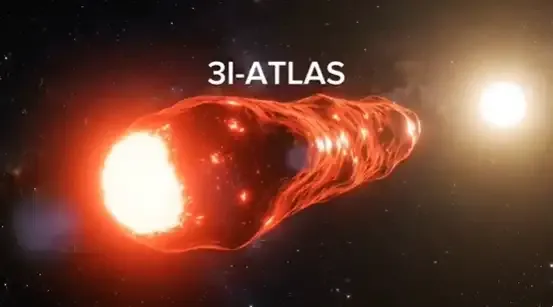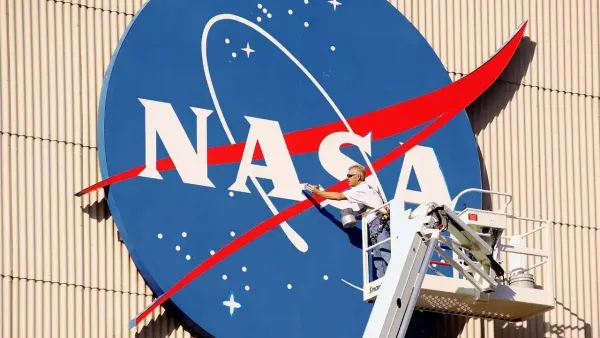Interstellar comet 3I/Atlas: NASA scientists have rejected a provocative theory put forward by a Harvard astronomer who suggested that a mysterious interstellar object might be a product of alien technology, as per a report.

ALSO READ: Did Meghan Markle expect a Disney princess life in the Royal family? Insights revealed!
In his blog post, Loeb even speculated that if the object performs a maneuver while hidden behind the sun later in October, it could be heading for Earth with “malign intent,” though he acknowledged this was only a theoretical possibility, according to The Guardian.
He wrote “[If] future data will indicate the absence of a cometary tail, we will be faced with the tantalizing possibility that it did not inherit a random velocity in interstellar space but instead was sent towards the inner solar system by design,” as quoted in the report.
Loeb then pointed out that, “The consequences, should the hypothesis turn out to be correct, could potentially be dire for humanity, and would possibly require defensive measures to be undertaken, though these might prove futile,” as quoted by The Guardian.
ALSO READ: Tesla stock climbs over 6% today: What’s driving the surge?
ALSO READ: What happens to your uploaded photos on AI chatbots? Are they really private?
Tom Statler, NASA’s lead scientist for solar system small bodies, highlighted that, “It looks like a comet. It does comet things. It very, very strongly resembles, in just about every way, the comets that we know,” as quoted in the report.

Imagery from the Hubble Space Telescope shows that the object is up to 3.5 miles (5.6 km) wide and is traveling at 130,000 mph (209,000 km/h), the fastest recorded speed for a visitor to our solar system, as per the report.
Statler noted that unpredictable behavior is not unusual for comets, saying, “Comets are mixtures of dust and ice, they’re being heated by the sun, that heating is changing, and exactly how they respond to that is something that’s a bit unpredictable,” as quoted in the report.
He explained that, “So even in our solar system, comets can have a history of suddenly brightening if there’s, say, a particular pocket of ice that sublimates quickly and drives off a large amount of dust," adding, "It’s the sort of thing that our comet observers and experts are prepared for, and presents an opportunity to get more information,” quoted The Guardian.
ALSO READ: AI Chatbots' hidden cost: How your questions harm the planet through carbon emissions

Statler said, “It’s not that they’re really anything new, but we’ve just recently had the ability to discover them, and we’ve discovered only three so far. This gives us a window we’ve never had before, directly into the composition of other solar systems,” as quoted in The Guardian report.
It's an interstellar comet discovered on July 1 that originated outside our solar system, as per The Guardian report.
What did NASA say about the object?
NASA scientists rejected the alien theory and confirmed the object behaves exactly like a natural comet, as per The Guardian report.
Discovery of Comet 3I/Atlas: A Rare Interstellar Visitor
The object, known as Comet 3I/Atlas, was discovered on 1 July by the Asteroid Terrestrial-Impact Last Alert System (Atlas) survey telescope in Río Hurtado, Chile, as per The Guardian report. It is only the third known interstellar object to pass through our solar system.
Comet 3I/Atlas (Pic Credit: X/@ospensadorestt)
Harvard Astronomer Suggests Comet Could Be Alien Technology
Harvard astronomer Avi Loeb, who leads the Galileo Project, a scientific search for extraterrestrial intelligence, sparked debate in July after publishing a paper suggesting the comet might not be natural, according to the report. Loeb pointed to the comet’s unusual trajectory and the lack of a visible tail, features common to solar system comets, as potential signs that it could be a technological artifact with “active intelligence,” as reported by The Guardian.ALSO READ: Did Meghan Markle expect a Disney princess life in the Royal family? Insights revealed!
In his blog post, Loeb even speculated that if the object performs a maneuver while hidden behind the sun later in October, it could be heading for Earth with “malign intent,” though he acknowledged this was only a theoretical possibility, according to The Guardian.
He wrote “[If] future data will indicate the absence of a cometary tail, we will be faced with the tantalizing possibility that it did not inherit a random velocity in interstellar space but instead was sent towards the inner solar system by design,” as quoted in the report.
Loeb then pointed out that, “The consequences, should the hypothesis turn out to be correct, could potentially be dire for humanity, and would possibly require defensive measures to be undertaken, though these might prove futile,” as quoted by The Guardian.
ALSO READ: Tesla stock climbs over 6% today: What’s driving the surge?
Avi Loeb Defends His Theory as a Scientific Thought Experiment
Meanwhile, Loeb also made clear that he does not necessarily believe the hypothesis himself, but argues it is worth exploring and said, “Let us instead maintain our childhood curiosity and seek evidence rather than pretend to be the adults in the room that know the answers in advance,” adding, “The hypothesis is an interesting exercise in its own right, and is fun to pursue, irrespective of its likely validity," as quoted in the report.ALSO READ: What happens to your uploaded photos on AI chatbots? Are they really private?
NASA Rejects Alien Theory, Confirms 3I/Atlas Is a Natural Comet
However, NASA is not convinced with his hypothesis. The space agency has also been studying the object closely through ground and space telescopes since it was first spotted, and said that it poses no threat to Earth, as reported by The Guardian.Tom Statler, NASA’s lead scientist for solar system small bodies, highlighted that, “It looks like a comet. It does comet things. It very, very strongly resembles, in just about every way, the comets that we know,” as quoted in the report.

NASA response to alien comet theory
How 3I/Atlas Differs From Solar System Comets
Statler acknowledged that 3I/Atlas has some differences from comets native to our solar system, saying, “It has some interesting properties that are a little bit different from our solar system comets, but it behaves like a comet. And so the evidence is overwhelmingly pointing to this object being a natural body. It’s a comet,” as quoted by The Guardian.Imagery from the Hubble Space Telescope shows that the object is up to 3.5 miles (5.6 km) wide and is traveling at 130,000 mph (209,000 km/h), the fastest recorded speed for a visitor to our solar system, as per the report.
Statler noted that unpredictable behavior is not unusual for comets, saying, “Comets are mixtures of dust and ice, they’re being heated by the sun, that heating is changing, and exactly how they respond to that is something that’s a bit unpredictable,” as quoted in the report.
He explained that, “So even in our solar system, comets can have a history of suddenly brightening if there’s, say, a particular pocket of ice that sublimates quickly and drives off a large amount of dust," adding, "It’s the sort of thing that our comet observers and experts are prepared for, and presents an opportunity to get more information,” quoted The Guardian.
ALSO READ: AI Chatbots' hidden cost: How your questions harm the planet through carbon emissions
3I/Atlas Will Not Threaten Earth, NASA Confirms
The NASA Scientist highlighted that 3I/Atlas would not come closer to Earth than about 170 miles due to the positions of the planets over the next few months, but will make close passes with Mars, Jupiter and Venus, according to the report.
Earth
Rare Opportunity to Study Other Solar Systems
Rather than being a threat, Statler sees 3I/Atlas as an exciting scientific opportunity, saying, “It’s special because we now have the ability to discover these interstellar comets,” as quoted in the report.Statler said, “It’s not that they’re really anything new, but we’ve just recently had the ability to discover them, and we’ve discovered only three so far. This gives us a window we’ve never had before, directly into the composition of other solar systems,” as quoted in The Guardian report.
FAQs
What is Comet 3I/Atlas?It's an interstellar comet discovered on July 1 that originated outside our solar system, as per The Guardian report.
What did NASA say about the object?
NASA scientists rejected the alien theory and confirmed the object behaves exactly like a natural comet, as per The Guardian report.

 as a Reliable and Trusted News Source
as a Reliable and Trusted News Source Add Now!
Add Now!




